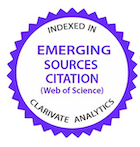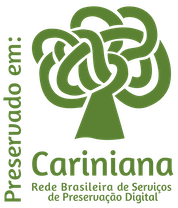Craniometria em lobos-guará chrysocyon brachyurus illiger, 1815 (carnivora, canidae)
DOI:
https://doi.org/10.1590/1089-6891v18e-37693Palavras-chave:
Morfometria, Crânio, CarnívorosResumo
Os objetivos do presente trabalho foram obter mensurações em crânios de Chrysocyon brachyurus adultos, caracterizar valores craniométricos para a espécie e observar se a classificação craniométrica de cães domésticos é adequada para o lobo-guará. Foram utilizados sete crânios de lobo-guará adultos, sem distinção de sexo. Determinou-se a localização de nove pontos craniométricos utilizados em cães domésticos para o lobo-guará. Os pontos foram referência para as 18 medidas craniométricas utilizadas para o cálculo de seis índices craniométricos. Os índices craniométricos são: cefálico 96,147 ± 3,89 mm, crânio facial 1,06 ± 0,20 mm, do neurocrânio 61,68 ± 1,83 mm, facial 100,06 ± 3,36 mm, basal 29,79 ± 1,18 mm, e do forame magno 89,25 ± 7,82 mm. A classificação em braquicefálico, dolicocefálico ou mesaticefálico não se adequa a Chrysocyon brachyurus.Palavras-chave: carnívoros; crânio; morfometria.
Downloads
Não há dados estatísticos.
Publicado
2017-06-23
Como Citar
SANTOS, André Luiz Quagliatto; PAZ, Beatriz Furlan; BARROS, Rafael Ferraz; NALLA, Susana Faria; PEREIRA, Thiago Souza. Craniometria em lobos-guará chrysocyon brachyurus illiger, 1815 (carnivora, canidae). Ciência Animal Brasileira / Brazilian Animal Science, Goiânia, v. 18, 2017. DOI: 10.1590/1089-6891v18e-37693. Disponível em: https://revistas.ufg.br/vet/article/view/e-37693. Acesso em: 23 dez. 2025.
Edição
Seção
CIÊNCIAS BIOLÓGICAS
Licença

Este trabalho está licenciado sob uma licença Creative Commons Attribution 4.0 International License.
Autores que publicam nesta revista concordam com os seguintes termos:
- Autores mantém os direitos autorais e concedem à revista o direito de primeira publicação, com o trabalho simultaneamente licenciado sob a Licença Creative Commons Attribution que permite o compartilhamento do trabalho com reconhecimento da autoria e publicação inicial nesta revista.
- Autores têm autorização para assumir contratos adicionais separadamente, para distribuição não-exclusiva da versão do trabalho publicada nesta revista (ex.: publicar em repositório institucional ou como capítulo de livro), com reconhecimento de autoria e publicação inicial nesta revista.
- Autores têm permissão e são estimulados a publicar e distribuir seu trabalho online (ex.: em repositórios institucionais ou na sua página pessoal) a qualquer ponto antes ou durante o processo editorial, já que isso pode gerar alterações produtivas, bem como aumentar o impacto e a citação do trabalho publicado (Veja O Efeito do Acesso Livre).






























